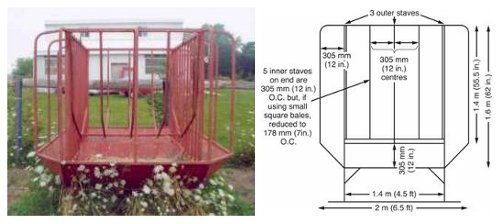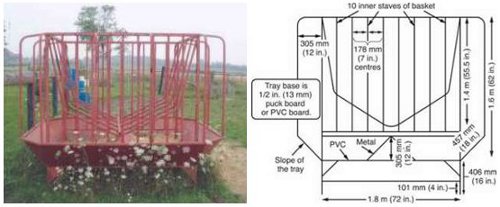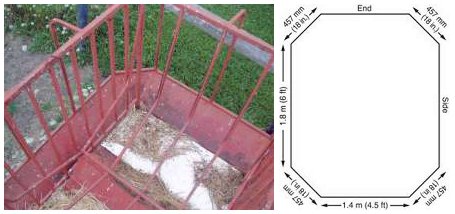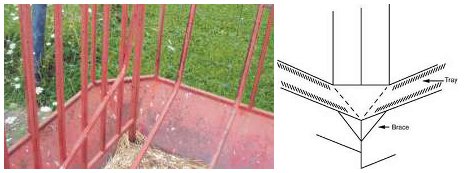Round-bale feeder for horses
Learn about round-bale feeders for horses.
ISSN 1198-712X, Published August 2006
Introduction
Baled hay is available in various sizes, including round bales varying from 1.2 m x 1.5 m to 1.8 m x 1.8 m (4 ft x 5 ft to 6 ft x6 ft), or large rectangular bales. These larger bales are being used to feed horses more than ever before, for several reasons:
- Harvesting ease — a much larger tonnage of hay can be handled per hour.
- Labour saving for harvest and storage — less manual labour is required to handle the hay. It is easier and cheaper to use tractors and mechanical means.
- Storage — mechanical handling makes it easy to store large volumes of hay, and storage facilities can be as simple as bale tarps.
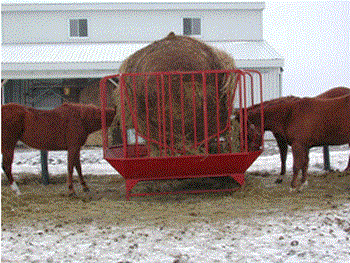
Offsetting these are several significant disadvantages that include:
- The need for a tractor with a front-end loader for storing the bales and transporting bales during the winter feeding period.
- The need for the feeders to be accessible year round regardless of the weather conditions (for example, snow or mud).
- The dustiness of round bales — Dust can be associated with the growth of mould on hay pre-baling and, with too high a moisture level in the bales and/or improper storage (moisture or humidity wicking up from below the bales), post-baling. See the information sheet Using and Feeding Round Bales to Horses on the OMAFRA website.
- The design of round-bale feeders, meant for cattle, which can be dangerous when used with horses.
Requirements of a good round-bale feeder for horses
A well-made feeder should incorporate the following design characteristics:
- A smooth-surfaced, solid-bottom pan that allows rain and snow melt to drain but catches the leaves, which the horses can vacuum up.
- Partially restricted access to the bale so there is less selection and less wastage. This is achieved by using a design with an inner basket to contain the bale.
- Sufficient overall height so the horses can't reach over and pull the hay from the bale.
- Sufficient chest height so the horses can't get a foot caught in the feeder when they paw.
- Easy to move with a tractor.
Advantages of using a feeder
Considering the substantial effort required to produce high-quality hay, an equal effort should, in turn, be made to minimize the losses from contamination and waste during the feeding process. Too often, a round bale is dumped into a field and, within a few days, the horses tear the bale apart, defecate and urinate on it, tramp it into the ground and use the remainder as expensive bedding. Hay fed on the ground is quickly contaminated with sand and parasites. Without the protection of a bale feeder, 50% of the dry matter content of bales can be lost. In addition, a huge clean-up job awaits you in the spring. The removal of this compacted, wasted hay, manure and ice necessitates a major effort with a tractor with a front-end loader.
A well-constructed feeder, such as the one shown below, reduces the waste hay to less than 10%. The inner basket keeps the hay off the ground and prevents the wicking of moisture from the ground. This is a major benefit over feeders that allow the bale to contact the ground.
Disadvantages of using a feeder
Feeders should not be accidents waiting to happen. They need to be well constructed and capable of withstanding the rough-housing of horses, including the rubbing of bums and necks. Areas around feeders are high traffic areas. They quickly become soupy, muddy places in the fall and spring of the year, especially in areas with high amounts of rainfall, poor drainage and heavy clay soils. When a feeder remains in the same location for most of the year, provisions should be made to improve the footing around the feeder. Options include moving the feeder regularly, constructing a cement pad extending distances of 3–4.6 m (10–15 ft) around the feeder or using landscape (geotextile) cloth. See the information sheet Management of Mud and Holes Around Gateways and High Density Areas on the OMAFRA website.
Feeder placement
Feeders should be easily accessible year round. When the snow flies and the drifts build, driving a tractor into a field with a 227 kg (500 lb) or-more bale mounted on a front-end loader can be a problem, unless you have 4-wheel drive. By placing the feeder perpendicular to the fence and adjacent to a driveway, which is kept open year round, the bales can be lifted over the fence and dropped directly into the feeder without entering the paddock. A feeder placed perpendicular to the fence divides the horse group in half and reduces the feed competition.
Round-bale feeder construction
The bale feeder described in this Factsheet is to be used with 1.2 m x 1.5 m (4 ft x 5 ft) round bales. It is best constructed with 25 mm (1 in) square tubing, welded so that there are no rough edges, corners or welds. The feeder consists of:
- An inner basket with staves (uprights to hold the hay and bale in place). The distance between inner staves can vary from 140 mm (5.5 in), if a lot of small, square bales are being used in addition to the round bales, to 305 mm (12 in). The wider spacing allows a person to crawl into the feeder from the side instead of over the top to remove waste material. However, a larger amount of hay will be pulled from the inner basket, increasing the wastage. The narrower spacing reduces the hay loss when using small, square bales but makes it a little harder for horses to eat a round bale that fits tightly into the basket.
- A tray that has sides angled upwards. Plastic PVC puck board (of at least 13 mm (1/2 in) thickness) is attached to the frame of the base. This is much easier for horses to keep clean.
- An outer frame with staves that support the structure and separate the horses when feeding
- The measurements are nominal, meaning that they are approximate sizes and are given in on-centre distances (O.C.).
This feeder is built for the typical, mature 15-hand horse and could be increased in size to accommodate draft horses. Quarter horse weanlings have had no problem eating from this bale feeder.
Constructing a round-bale feeder for horses
